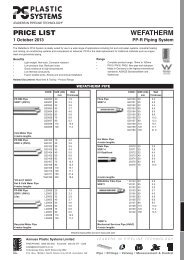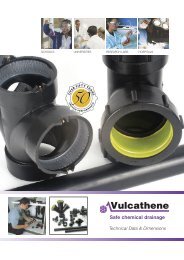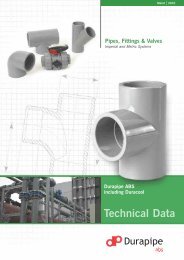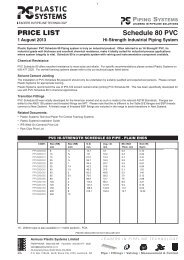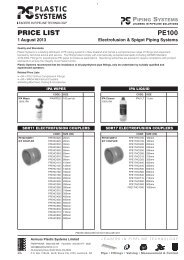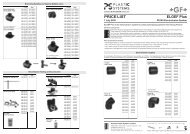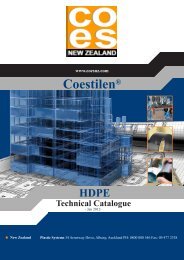Beta (b)-PP from Georg Fischer A synonym for ... - Plastic Systems
Beta (b)-PP from Georg Fischer A synonym for ... - Plastic Systems
Beta (b)-PP from Georg Fischer A synonym for ... - Plastic Systems
You also want an ePaper? Increase the reach of your titles
YUMPU automatically turns print PDFs into web optimized ePapers that Google loves.
<strong>Beta</strong>-<strong>PP</strong>-H <strong>from</strong> <strong>Georg</strong> <strong>Fischer</strong><br />
A <strong>synonym</strong> <strong>for</strong> proven toughness and chemical resistance<br />
Industrial plant operators, particularly those in the<br />
chemical industry, place significantly higher demands<br />
on the piping materials <strong>for</strong> their systems<br />
than they would <strong>for</strong> standard water applications.<br />
Characteristic features of this requirement profile<br />
are:<br />
- frequent changes in thermal load over a relatively<br />
wide range<br />
- the compensation of linear thermal expansion<br />
- the occurrence of dynamic stress load or hydraulic<br />
impact<br />
- a much higher awareness <strong>for</strong> security and<br />
cost measures when hazardous chemicals (often<br />
media hazardous to ground water, e.g.<br />
strong acids or bases) need to be conveyed<br />
- no downtime<br />
- less maintenance<br />
The <strong>Beta</strong>-<strong>PP</strong>-H material used by <strong>Georg</strong> <strong>Fischer</strong> is<br />
ideal <strong>for</strong> these application areas.<br />
The major advantages of <strong>Beta</strong>-<strong>PP</strong>-H compared to<br />
other <strong>PP</strong> types are explained in this technical brochure.<br />
Considering the requirement profile above, it is<br />
obvious that the impact strength of the material<br />
plays a decisive role in piping system construction.<br />
High impact resistance warrants maximum<br />
safety against un<strong>for</strong>eseeable impact in transport,<br />
in installation and last but not least in operation of<br />
the system.<br />
This is why <strong>Georg</strong> <strong>Fischer</strong> recommends the material<br />
<strong>Beta</strong>-<strong>PP</strong>-H.<br />
• Systematic tests spanning several years and<br />
including various materials confirm the extraordinarily<br />
high impact strength of this material<br />
even at low temperatures. Note that also<br />
the welding zone shows the continuation of<br />
the beta-properties.<br />
• In particular, it has been shown that an adaptation<br />
of the reduction factors (A4) of <strong>Beta</strong>-<strong>PP</strong>-<br />
H to those of <strong>PP</strong>-R is entirely justifiable.<br />
• The excellent chemical resistance and the<br />
high stiffness of <strong>Beta</strong>-<strong>PP</strong>-H round off the profile<br />
of this material ideal <strong>for</strong> the chemical industry.<br />
The different <strong>PP</strong> types<br />
<strong>PP</strong> belongs to the class of semi-crystalline polymers,<br />
whose ordered (crystalline) phase can occur in various<br />
modifications. The type and content of the crystalline<br />
phase determines the mechanical properties, such as<br />
stiffness and toughness of the material to a large extent.<br />
It is a well-known fact that the impact strength of<br />
<strong>PP</strong> can be significantly increased (compared to Alpha-<br />
<strong>PP</strong>), without any noteworthy loss in the rigidity of the<br />
material, by the <strong>for</strong>mation of the beta phase as crystallite<br />
modification. Basically, this beta phase is realized<br />
by adding traces of special nucleating agents. It is the<br />
processing that has a decisive impact on the extent to<br />
which the beta phase and the related positive material<br />
properties are realized in the end product. Combined<br />
with the nucleating agents, it is exactly these factors<br />
which determine the <strong>for</strong>mation of a homogenous and<br />
fine structure with minimal internal stress.<br />
Fig.1: Structure of non-nucleated <strong>PP</strong>-H (left) and nucleated<br />
<strong>Beta</strong>-<strong>PP</strong>-H (magnification = 80x; transmitted light,<br />
polar; 15 µm microtomic section)<br />
There are three different types of polypropylene generally<br />
used in piping systems construction today:<br />
- <strong>PP</strong> homopolymer (<strong>PP</strong>-H; Type 1); Standard (Alpha-)<br />
<strong>PP</strong>-H and <strong>Beta</strong> <strong>PP</strong>-H belong to this category<br />
- <strong>PP</strong> block copolymer (<strong>PP</strong>-B; Type 2)<br />
- <strong>PP</strong> random copolymer (<strong>PP</strong>-R, Type 3).<br />
<strong>PP</strong> as a polyolefin belongs to the class of non-polar<br />
materials, whose surface hardly swells or is difficult to<br />
dissolve; so-called functional groups are not present in<br />
the material without pre-treatment. Solvent cementing<br />
is there<strong>for</strong>e not possible without special surface treatment<br />
and also not possible under field conditions.<br />
However, <strong>PP</strong> can be fused very easily. For pressure<br />
piping, heating element socket fusion, heating element<br />
butt fusion and the non-contact infrared (IR-Plus®)<br />
fusion technology developed by <strong>Georg</strong> <strong>Fischer</strong> are<br />
used.<br />
The excellent cost-per<strong>for</strong>mance ratio renders <strong>PP</strong> in<br />
combination with its extensive chemical resistance and<br />
its attractive range of properties (even under higher<br />
temperatures) a very interesting piping system material.<br />
3



